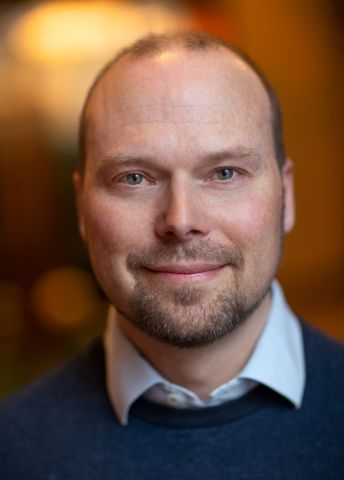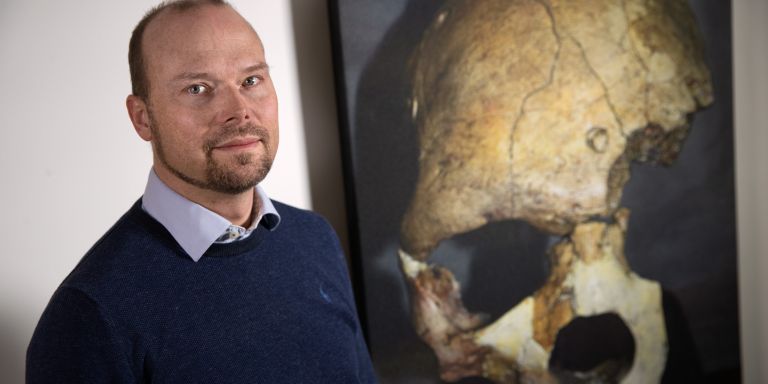
Mattias Jakobsson
Professor of Genetics
Wallenberg Scholar
Institution:
Uppsala University
Research field:
Human evolution


Wallenberg Scholar
Institution:
Uppsala University
Research field:
Human evolution
According to established research, modern humans originated in East Africa about 160,000 years ago. The region is a goldmine for archeologists, thanks to East African burial practices, allowing the remains of humans and animals to be preserved well in the sediment. This area is home to the oldest known fossils of modern humans.
But recent findings suggest that modern humans have probably existed for twice as long – some 300,000 years – and may originate from southern Africa rather than East Africa.
Jakobsson, who is a professor of genetics at Uppsala University and a Wallenberg Scholar, is one of the researchers behind the new findings.
“Our research shows that modern humans evolved much earlier than has been believed.”
The researchers have performed DNA analyses on a number of prehistoric humans, in this case from the KwaZulu-Natal area of southern Africa. One key subject is a boy from Ballito Bay, who lived some two thousand years ago on the east coast of South Africa.
“The boy died at the age of seven, and was buried on a beach. It’s often problematic to extract DNA from remains in hot, humid areas, but we managed to sequence the boy’s entire genome.”
The researchers are using the data they obtain to make comparisons with other individuals and populations, including present-day inhabitants. Genetically, the boy from Ballito Bay is fairly similar to the Khoe-khoe and San tribes – Indigenous peoples now found south of the Sahara.
“These are people who have lived a traditional hunter–gatherer existence, people who were present in southern Africa when the first Europeans arrived,” Jakobsson explains.
But the boy from Ballito Bay also differs more genetically from West African and East African tribes than do the present-day Khoe-khoe and San people.
“These ethnic groups carry DNA that can be traced to a migration from East Africa some two thousand years ago. When we compare the boy’s genome with present-day individuals, we can infer that a branching occurred about 300,000 years ago.
The researchers have also been able to replicate their results.
“If we take a person living in southern Africa today and remove the genetic components deriving from East Africa, we arrive back at the same branching that took place 300,000 years ago.”
The findings challenge the accepted view that the cradle of humanity was in East Africa. It may be that modern humans originate from southern Africa – a region that archeologists have not studied to the same extent.
But human prehistory may also be more complex than so. One theory suggests that modern humans may have evolved in several places simultaneously.
“But this leads to a biological paradox. It’s hard to conceive of such selective pressure and the same processes taking place in such a short space of time in several places at the same time. We haven’t seen anything like it in any other species,” Jakobsson points out.
“The Wallenberg Scholar grant gives me the freedom and the economic means to take on high-risk projects. It really is a gift for a researcher to be able to work without the normal constraints. Thanks to the Wallenberg Foundation, Sweden has a unique position in the world in the field of independent and free-thinking research.”
The technological strides made in recent years have made it possible to analyze huge quantities of DNA. And techniques for extracting prehistoric DNA from fossils are also improving.
“Ten years ago no one could have guessed we’d be able to do the things we do today. There has been an amazing increase in the amount of data we can produce. We’re now able to analyze millions of markers, and we have completely new tools for examining evolutionary and genetic questions.”
The aim is to impact the archeological material as little as possible.
“We work closely with museums, and make sure to take samples as unobtrusively as possible. For instance, we might remove a tooth from a jaw, take out the root underneath it and then replace the tooth, without leaving any sign that we have taken a sample.”
As a Wallenberg Scholar, Jakobsson is continuing to piece together the evolutionary puzzle of early human history. The idea is to link up more information from genomics, archeology and paleoanthropology in southern and central Africa. In one project he is sequencing a hundred prehistoric human remains from various sites, and comparing them with the genome in Indigenous groups in the same regions.
“I not only want to map the genes; I also want to understand the genetic process in detail. It’s a question of identifying the genetic changes that made humans clever, driven and good engineers several hundred thousand years ago.”
The extent of our genetic similarities with the humans who lived 300,000 years ago is unclear.
“We won’t know until we’ve managed to obtain DNA from a fossil of that age. At present the idea of finding well-preserved DNA that old in the hot African climate belongs to the realm of science fiction.”
The fundamental question underlying the research concerns our very existence.
“How is it that humans evolved from a common ancestor with chimpanzees to become Homo sapiens? We’ll never find a specific point in time at which earlier hominids evolved to become modern humans. We know it was a gradual process.”
Text Nils Johan Tjärnlund
Translation Maxwell Arding
Photo Magnus Bergström